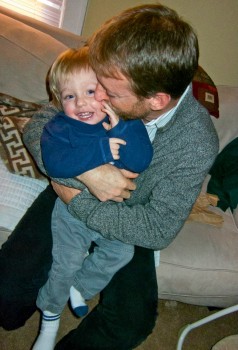The other day I yelled at my 2-year-old son Dylan after one of his wooden blocks bounced off my forehead, narrowly missing my eye. “NO!,” I shouted. “You DO NOT throw things!”
I thought I was being as clear and direct as possible, but if I put myself in young Dylan’s shoes, this is not clear at all. Only the day before I was congratulating Dylan for throwing me a ball in the park, so clearly, sometimes it is OK to throw things and sometimes it isn’t.
In fact, the rules around throwing things are fairly complex: Throwing hard things seems to be worse than throwing soft things. Throwing things at people is not good when they are not expecting it but OK if you are engaged in a game of catch. Some things are OK to throw outside but not in the house. You shouldn’t throw rocks at cars but it is OK to throw them into a lake. Sand at the beach shouldn’t be thrown at people or onto peoples’ blankets but is OK if no one is around, etc. etc. etc.
As a parent, even if I wanted to be crystal clear in my communication, it is virtually impossible to verbally convey all of the subtle contextual cues that determine whether throwing is appropriate or not. And so Dylan has no choice but to experiment—to test the boundaries—by throwing things over and over again until he learns all the rules (insert exasperated parental sigh here.)
Even a seemingly black-and-white rule, such as “no hitting” has contextual variability. If Dylan smacks his younger brother in the face, he gets yelled at, but if he gently pats him on the back, he is told he is being sweet. For Dylan, there is a wide gray area between these two that will have to be explored and tested. Hitting someone in the face is not so good, but it’s ok to hit someone’s hand when they say “give me five!” Banging on a toy drum with a stick is allowed, but banging on the television or your younger brother’s head is taboo.
It is easy for parents to become frustrated with a child for not “following the rules,” but when you look at the contextual landscape surrounding each rule, you realize that toddlers have their work cut out for them.
As a new parent, I went into this thinking that the conventional wisdom applied: You have to be clear. You have to be consistent. But life is neither clear nor consistent. Black-and-white rules are rarely helpful (and often ignored.)
One of the best books I’ve seen on the complexities of parenting is “What Your Child Needs From You: Creating a Connected Family” by parenting expert, Dr. Justin Coulson. At less than 80 pages, it’s an easy read for the time-starved parent, but it gets at the essence of the parental relationship, and doesn’t shy away from the contextual nuances and challenges that can be a part of any interaction.
With respect to discipline, Coulson reminds people there are two important aspects to consider: the behavior you want the child to create AND the reason you want the child to have for adopting the behavior. I.e. do we want to raise children that learn to “follow the rules” and unquestioningly bow to authority? Or do we want to raise children that internalize good behavior because they have a strong set of values and a good understanding of the contextual landscape they are attempting to navigate?
One of the techniques that Coulson recommends is “induction” and he uses an example of a two-year-old boy stabbing his older brother in the face with a fork (and I thought the block hurt!) The understandably natural reaction of the father was to yell at the child and enforce a “time-out”.
Induction is the process of teaching the expectations that we have of a child. But Coulson realizes that simply explaining the rules and meting out punishment can be confusing to a child this age. The best way to create a teachable moment is to get the child talking about what happened so the new rules and guidelines become internalized rather than enforced from without.
So rather than handing down parental commandments, I’m looking for the teachable moments on context. “Dylan, can you tell me why Daddy got angry when you bounced one of your blocks off of his forehead?”
Coulson’s book is all about emotional availability. Children, more than anything, need to be heard. Even when we think there is a lesson they need to learn.
—
References and recommended reading:
Coulson, J. (2012). What Your Child Needs From You: Creating a Connected Family. ACER Press.
by Jeremy McCarthy
Connect with me on facebook, twitter, or pinterest.
Now available: New e-book on The Psychology of Spas and Wellbeing.



Oh boy – the patience you need as a parent. Taxes my self-regulation on a daily basis! Bring on the chocolate! Nicely written article – thanks for the reassurance that we’re not alone! 🙂
Ahhhh, you wrapped it up so nicely! “Children, more than anything, need to heard”. You are correct, how are our children supposed to navigate the confusing territory of “yes” and “no”. We need to try and see life from their perspective, i.e., empathy, the magic bullet. When our children are truly understood and we build a basis of trust and mutual respect, the skies the limit to a beautiful, successful relationship with them. Of course, there will always be strugggles, life is beautiful not perfect!
Thank you for communicating from “their” perspective so beautifully!
As always, Jeremy you translate parenting (and all info for that matter) into memorable tasty bites that stick to my ribs. What a super gift for any parent or grand parent.
I love how you think like a regular guy adult, then get down on the jungle floor where your kid is playing where the “lions and tigers and bears, oh my!” roam, Then you morph back to adult level, taking joy in discovering life as they are, inquisitive and trying t find their way back to adult Mommy and Daddy world.
Man, are your kids lucky! Bet you and Todd Kashdan have one cool times comparing guys and gals! What a book that would be!
Jeremy, what a great post!
I think when it comes to parenting there are often no easy answers. It’s a complicated gig. But if we really look at the few things kids really need from us, it boils down to these three things you’ve highlighted:
1. They need our emotional availability. We need to really be where our feet are.
2. They need to be understood. Not just at the cognitive level, but deep down. We need to see the world through their eyes, looking into their heart. And
3. They need us to guide them – to teach them good ways to act. And asking those questions can be one of the most effective tools, because they’re the ones doing the talking, and therefore the learning, rather than us.
Loved the stories. Loved the emphasis on context.
And thanks so much for taking a close look at my book. I’m delighted you got so much from it.
Justin
Many thanks, Justin for your 3-step that will make parents dance!
Continued success.